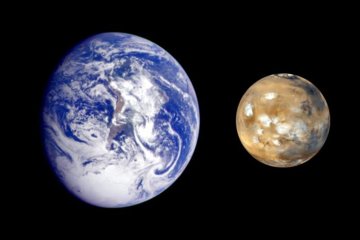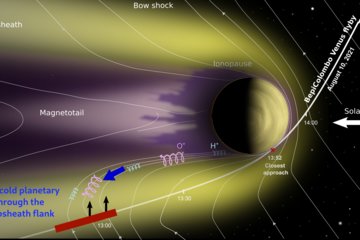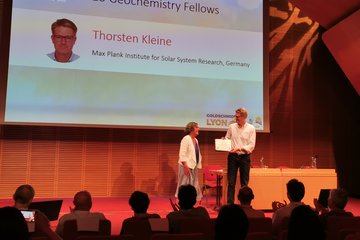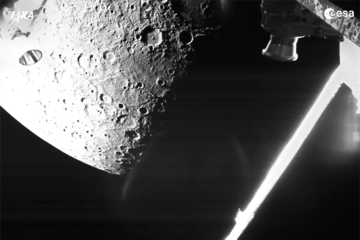Paul Niggli Medal for Dr. Christian Renggli
The MPS researcher investigates volcanic eruptions on Earth, the Moon and Mercury and looks closely at the interactions between gases and minerals.
The Swiss Geological Society (German: Schweizer Geologische Gesellschaft (SGG)) has awarded the Paul Niggli Medal 2023 to Dr. Christian Renggli from the Max Planck Institute for Solar System Research (MPS). The committee thus honoured his experimental research on gas-solid reactions, which brought our understanding of volcanoes on Earth and throughout the Solar System on a similar level. Among other things, Dr. Renggli studies the composition of the gases that drove the explosive volcanism on the Moon billions of years ago. In addition, his work on the distribution of sulphur on Mercury points to a possible mechanism for the formation and weathering of sulphur crusts. This could explain the depressions on Mercury's surface that have puzzled scientists since their discovery. From 2025, the Mercury probe BepiColombo, to which the MPS is also contributing scientific instruments, could test whether this hypothesis is correct.

Shaken champagne bottles and explosive volcanoes have one thing in common: it is the released gas that drives the eruption. Volcanoes have been found throughout the Solar System for billions of years, from Earth's fire belts to the extinct vents on Mars and the most active body in the Solar System, Jupiter's moon Io. The emitted gas sometimes reacts with the surrounding rock and can still be found today in samples such as those from the Apollo missions. Scientists like Dr. Renggli can learn a lot from the gases and their interaction with the environment, even if the volcanoes have long been extinct.
A new model developed by him and his colleagues deals with the question of what the gases that fueled lunar volcanism are composed of and how the trace amounts of metals are transported in such gases. This transport depends on the chemical form of the metal - iron, for example, can occur with two (Fe2+) or three (Fe3+) positive charges - and is influenced by variables such as temperature, pressure, gas composition and the availability of reactive oxygen.
Using the new model, Dr. Renggli was able to show that metal in its natural form can be expected near the former volcanoes on the Moon, while the proportion of metal-sulphur compounds increases with increasing distance. In addition, the transport of metals in volcanic gases on Earth is more effective than on the Moon due to the changed conditions, e.g. Earth having an atmosphere.
In recent years, the Swiss-born scientist has focussed on volcanism on Mercury, the planet closest to the Sun. Since the Mariner 10 flyby in the 1970s, NASA's Messenger spacecraft (2004-2015) orbited and mapped the planet for the first time. It found large sulphur deposits on its surface as well as shallow depressions with a size of a few kilometres at most that are still enigmatic for scientists today.
Laboratory experiments by Dr. Renggli and his colleagues now allow conclusions about a mechanism that could be the cause of the depressions. In his work, the researcher investigated the interaction between gaseous sulphur, as it occurs during volcanic eruptions, with minerals such as those detected by Messenger on the surface of Mercury. The experiments show that the sulphur gas reacts with the minerals and accumulates. On the one hand, this could explain the sulphur deposits on Mercury's surface; on the other hand, the deposits are not stable indefinitely. The sulphur crust is eroded by cosmic influences such as radiation from the Sun or impacts of tiny meteorites. This could explain the observed depressions. Whether the hypothesis is correct could become apparent as early as 2025, when the third research mission to Mercury, ESA’s mission BepiColombo, enters its orbit.
Currently, Dr. Renggli is setting up a new high-temperature experimental laboratory at the MPS. He will use new methods to investigate the interactions between magma oceans and hot atmospheres, as can be observed on distant exoplanets. From these experiments, he also hopes to draw conclusions about the development of terrestrial planets in the Solar System. These also had magma oceans in their early stages of development.
Dr. Renggli received his doctorate in Canberra, Australia, in 2018 after studying geology in Bern and Munich. From 2018 to 2023, he worked at the University of Münster (Germany). The scientist has been researching at the MPS since October 2023.
The Paul Niggli Medal is considered Switzerland's most prestigious award for young scientists in the field of geosciences. It has been awarded annually since 1988 by the Swiss Geological Society for outstanding achievements in the fields of mineralogy, geochemistry, petrology, raw material geology or solid-state geophysics. The award winners must not be older than 35 years of age and must either be Swiss citizens or have obtained at least two academic degrees in Switzerland. The namesake, Paul Niggli (1888 - 1953), was a Swiss geoscientist and crystallographer. Niggli became famous for his research into the arrangement of atoms in crystal lattices.












